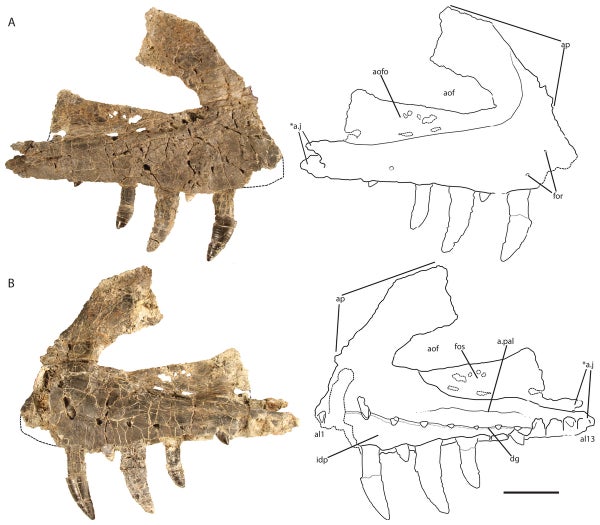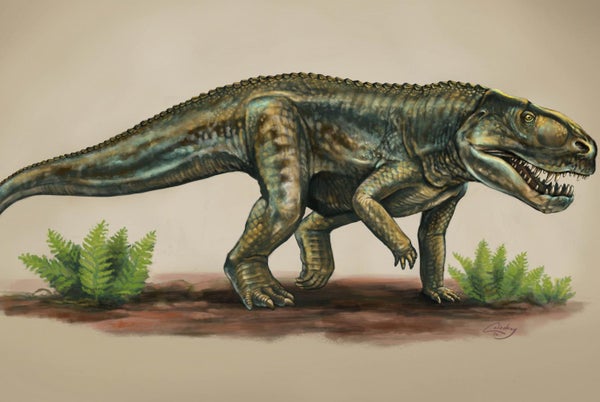This article was published in Scientific American’s former blog network and reflects the views of the author, not necessarily those of Scientific American
For many fossil fans, Ghost Ranch is synonymous with Coelophysis. Hundreds of skeletons of this Triassic dinosaur were found there in the 20th century, along with a few of its ancient neighbors, yet there's far more to this swath of New Mexico desert than the sleek little theropod. There's another major bonebed at Ghost Ranch that has yielded a whole menagerie of Triassic creatures, including a gnarly carnivore that has just been given a formal name.
When the sediments of the Hayden Quarry - named for its discoverer John Hayden - were being laid down, dinosaurs were not the baddest carnivores around. That distinction belonged to the rauisuchids - ancient relatives of crocodiles with severing smiles and that ran around with their legs held straight beneath their bodies. Now, thanks to a smattering of skull elements and other pieces found in the Hayden quarry, paleontology student Emily Lessner and coauthors have recognized that the species found there is one never seen before. They've named it Vivaron haydeni.
Up until now, all other rauisuchid bones found in the American southwest were attributed to an animal Postosuchus, Lessner and coauthors write. Vivaron demonstrates that there are other unrecognized species out there. Some may have already been found and lumped in with Postosuchus. This isn't just a matter of taxonomic reshuffling. Rauisuchids lived in different habitats across Pangea during 16 million years of the Triassic, often the largest and most menacing carnivores of their time. If we're going to envision what the Dawn of the Dinosaurs was like, we can't do so without a clearer view of the rauisuchids that stalked the ancient forests.

A jaw bone from Vivaron. From Lessner et al. 2016
On supporting science journalism
If you're enjoying this article, consider supporting our award-winning journalism by subscribing. By purchasing a subscription you are helping to ensure the future of impactful stories about the discoveries and ideas shaping our world today.
Fossil Facts
Name: Vivaron haydeni
Meaning: Vivaron is a reference to a giant, mythical rattlesnake said to slither around Orphan Mesa in the vicinity of the quarry, while haydeni honors locality discoverer John Hayden.
Age: Triassic, 212 million years old.
Where in the world?: Ghost Ranch, New Mexico
What sort of critter?: A distant cousin of crocodiles called a rauisuchid.
Size: Estimated at 12 to 18 feet long.
How much of the creature’s body is known?: Elements of the jaws, skull, and hips.
Reference:
Lessner, E., Stocker, M., Smith, N., Turner, A., Irmis, R., Nesbitt, S. 2016. A new rauisuchid (Archosauria, Pseudosuchia) from the Upper Triassic (Norian) of New Mexico increases diversity and temporal range of the clade. PeerJ. doi: 10.7717/peerj.2336
Previous Paleo Profiles:
The Light-Footed Lizard The Maoming Cat Knight’s Egyptian Bat The La Luna Snake The Rio do Rasto Tooth Bob Weir's Otter Egypt's Canine Beast The Vastan Mine Tapir Pangu's Wing The Dawn Megamouth The Genga Lizard The Micro Lion The Mystery Titanosaur The Echo Hunter The Lo Hueco Titan The Three-Branched Cicada The Monster of Minden The Pig-Footed Bandicoot
